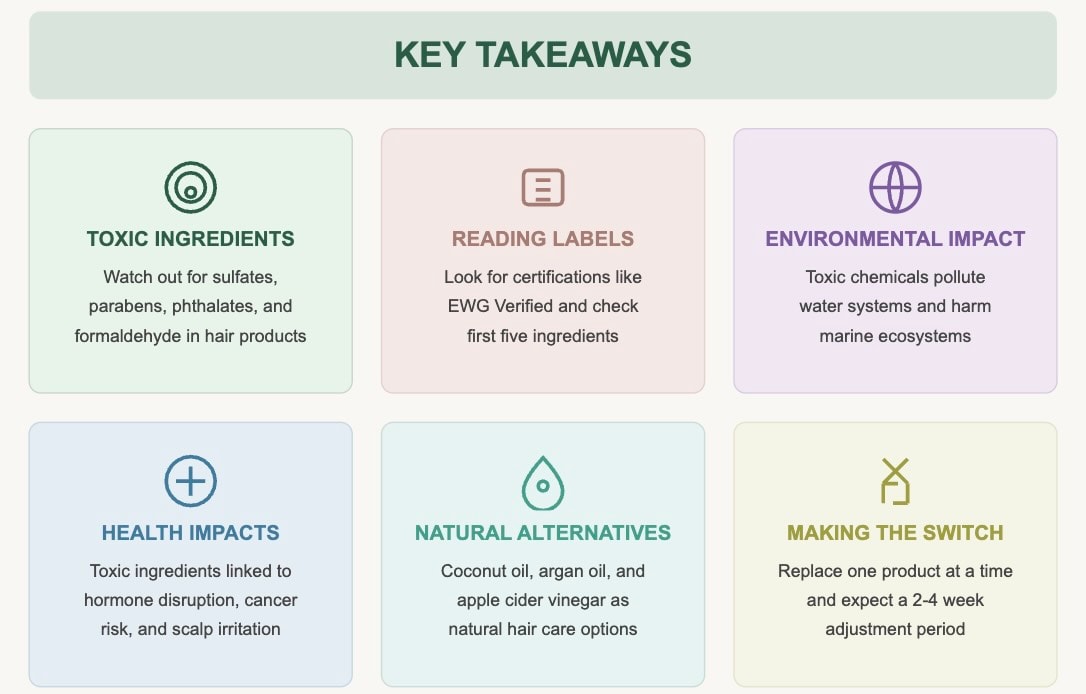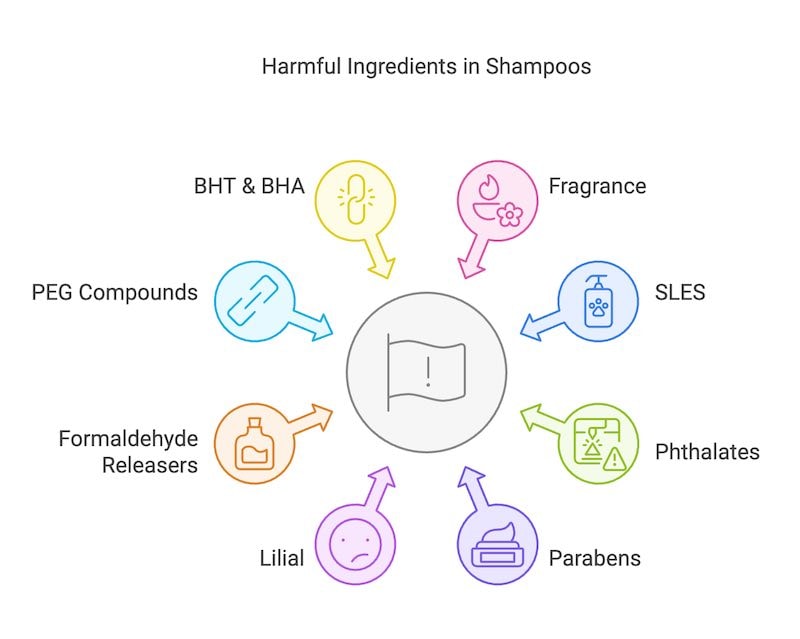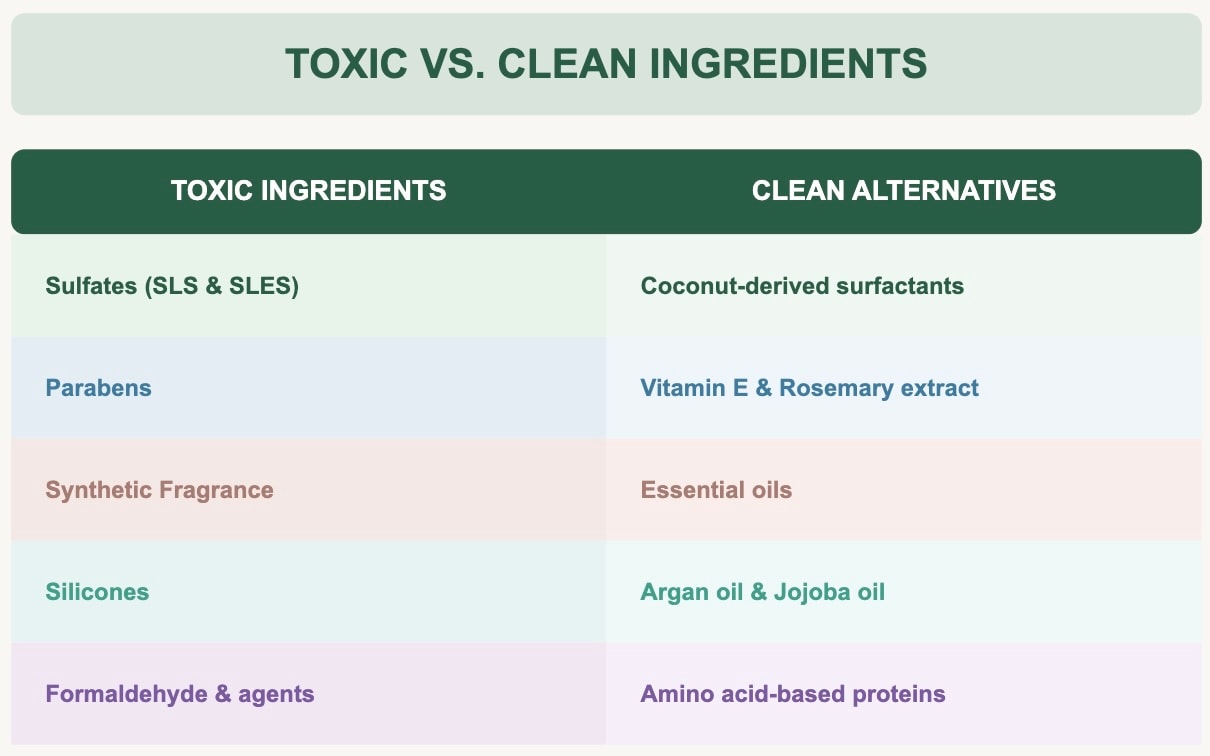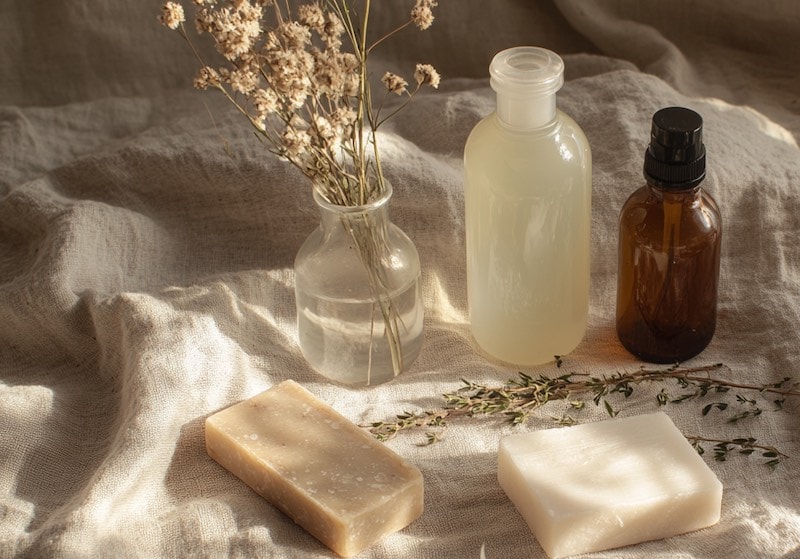Table of Contents
9 Schädliche Inhaltsstoffe in Haarpflege, die du unbedingt meiden solltest
This page may contain affiliate links. We may earn a commission on purchases, at no additional cost to you. Learn more →
Hast du dich schon einmal gefragt, warum dein Haar trotz teurer Pflegeprodukte trocken, brüchig oder fettig wirkt? Was wäre, wenn ich dir sage, dass deine Lieblingsprodukte dein Haar heimlich schädigen könnten?
Studien zeigen, dass Haarprodukte die dritthäufigste Kategorie von Kosmetik-Artikeln sind, die mit Krebsfällen in Verbindung gebracht werden (8,3%). Viele konventionelle Marken verwenden Formeln, in denen versteckte Schadstoffe wie Sulfate, Parabene und Phthalate stecken, die Haarausfall, Kopfhautreizungen, hormonelle Ungleichgewichte und sogar ein erhöhtes Krebsrisiko verursachen können!
In diesem Artikel erfährst du, welche schädlichen Inhaltsstoffe in Haarpflegeprodukten du unbedingt meiden solltest, wie du irreführende Etiketten entschlüsselst und wie du sichere, schadstoffreie Alternativen für gesünderes Haar erkennen kannst. Betrachte das Ganze als deinen persönlichen Crashkurs für ein schadstoffreies Leben, damit du dein Haar und dein allgemeines Wohlbefinden auf schonende Weise unterstützt.

Die versteckten Risiken giftiger Haarinhaltsstoffe
Deine Haarpflegeroutine kann dir mehr schaden als nützen – und zwar nicht nur deinem Haar, sondern deinem gesamten Körper. Produkte, die du auf dein Haar aufträgst, dringen in deine Kopfhaut ein, eine der durchlässigsten Stellen deines Körpers. Das heißt, dass Chemikalien innerhalb weniger Minuten in deinen Blutkreislauf gelangen können!
Ich persönlich habe Haarausfall durch bestimmte Produkte und extreme Trockenheit beziehungsweise Stumpfheit durch andere erlebt. Meine Faustregel: Je weniger Inhaltsstoffe ich nicht aussprechen kann, desto besser. Und bei Shampoos gilt: Weniger Schaum = weniger Schaden.
Außerdem solltest du im Hinterkopf behalten, dass schädliche Chemikalien nicht nur in Haarpflege lauern. Lies zum Beispiel unseren Artikel über 5 schädliche Haushaltsprodukte, die wir täglich benutzen, um noch mehr Wege zu entdecken, wie du Schadstoffe im Alltag vermeiden kannst!
Kurzfristige Gesundheitsauswirkungen
-
Reizung von Kopfhaut und Haut (allergische Dermatitis und Juckreiz)
-
Verstärkter Haarbruch, Haarausfall und Frizz
-
Trockenheit oder übermäßige Talgproduktion
Langfristige Gesundheitsauswirkungen
Die langfristigen Folgen giftiger Haarprodukte können noch gravierender sein. Studien weisen darauf hin, dass eine anhaltende Belastung durch bestimmte Inhaltsstoffe in Haarpflege das Risiko für ernste Gesundheitsprobleme erhöhen kann, zum Beispiel:
-
Hormonstörungen: Chemikalien wie Parabene und Phthalate wirken wie Östrogen und können die Hormonregulation durcheinanderbringen. Studien verknüpfen sie mit polyzystischem Ovarialsyndrom (PCOS), Schilddrüsenerkrankungen sowie Fruchtbarkeitsproblemen bei Männern und Frauen. Da viele Kosmetik- und Haarprodukte endokrine Disruptoren enthalten, ist es wichtig zu wissen, wie man diese vermeidet.
-
Erhöhtes Krebsrisiko: Chemikalien in Haarprodukten werden mit höheren Raten von Gebärmutter-, Brust- und Lungenkrebs in Verbindung gebracht.
-
Chronische Krankheiten & Organschäden: Haarpflege-Chemikalien stehen in Zusammenhang mit chronischen Erkrankungen wie Diabetes und Lupus.

Die Auswirkungen auf die Umwelt
Nicht nur dein Körper zahlt einen Preis – auch die Umwelt ist betroffen. Jedes Mal, wenn du dein Haar wäschst, fließen Schadstoffe wie Parabene und Phthalate ins Abwasser, verunreinigen unser Trinkwasser, schaden Meereslebewesen und verschmutzen den Boden, auf dem unsere Nahrungsmittel wachsen. Viele dieser Inhaltsstoffe bauen sich nicht von selbst ab und sammeln sich mit der Zeit an, was Ökosysteme stört und die Artenvielfalt bedroht. Innerhalb der EU regelt etwa die Europäische Kosmetikverordnung (EG Nr. 1223/2009) sowie das Bundesinstitut für Risikobewertung (BfR) den Einsatz vieler Inhaltsstoffe. Importierte Produkte können allerdings weiterhin problematische Stoffe enthalten.
Welche Stoffe sollten nicht in einem Shampoo sein? - 9 Schädliche Inhaltsstoffe in Haarpflege
1. Sulfate (SLS & SLES) – Entzug der natürlichen Haaröle
Wenn dein Shampoo stark schäumt, sind oft Sulfate wie Sodium Lauryl Sulfate (SLS) und Sodium Laureth Sulfate (SLES) am Werk. Diese aggressiven Tenside lösen zwar Schmutz und Öl, entziehen deiner Kopfhaut jedoch auch wichtige Feuchtigkeit und können sie austrocknen.
Warum du sie meiden solltest
-
Vermehrte Talgproduktion: Ist die Kopfhaut zu trocken, produziert sie mehr Öl. Ergebnis: fettiger Ansatz, trockene Längen und Spitzen – ein Teufelskreis.
-
Farbverlust & Frizz: Sulfate heben die Schuppenschicht an, was gefärbtes Haar schneller verblassen lässt und zu Frizz sowie Haarbruch führen kann – besonders bei lockigem oder texturiertem Haar.
-
Kopfhautreizung: Bei empfindlicher Haut oder Ekzemen können Sulfate Beschwerden verschlimmern.
Woran du sie erkennst: Achte auf alles, was auf „-sulfate“ endet, z. B. „Ammonium Lauryl Sulfate“.
2. Parabene – Die stillen Hormonstörer
Parabene gelten als Konservierungsstoffe, die Produkte haltbarer machen und Bakterien- sowie Schimmelbefall vorbeugen. Allerdings ahmen sie Östrogen nach und greifen damit in dein endokrines System ein. Das Risiko für Fortpflanzungsprobleme und Brustkrebs könnte sich dadurch erhöhen.
Warum du sie meiden solltest
-
Aufnahme im Körper: Studien fanden Parabene bereits im Urin, Blut und Brustgewebe. Das wirft Fragen zu einer möglichen Langzeitbelastung auf.
Woran du sie erkennst: Endungen wie „-paraben“, z. B. Methylparaben, Propylparaben, Butylparaben, Ethylparaben.
3. Phthalate & Duftstoffe – Die verschwiegene Gefahr
Ist dir aufgefallen, dass manche Haar- und Kosmetikprodukte stundenlang intensiv duften? Dahinter stecken häufig Phthalate, die Duftstoffe stabilisieren und deren Haltbarkeit verlängern. Wie bei anderen bedenklichen Stoffen in Make-up und Pflege verstecken sich Phthalate häufig hinter Sammelbegriffen wie „Fragrance“ oder „Parfum“ und sind somit schwer zu erkennen.
Vielleicht fragst du dich, warum Duftstoffe problematisch sein können. Tatsächlich können diese „Düfte“ eine Mischung aus Hunderten unbekannten Chemikalien sein, die unter dem Etikett „Betriebsgeheimnis“ nicht offengelegt werden.
Warum du sie meiden solltest
-
Empfindliche Kopfhaut: Phthalate und synthetische Duftstoffe können laut Studien die Kopfhaut reizen und zu Rötungen, Juckreiz sowie Haarausfall führen.
-
Gesundheitliche Risiken: Langzeitbelastung mit Phthalaten wird mit erhöhtem Asthma-Risiko, Entwicklungsverzögerungen und verminderter Spermienzahl bei Männern in Verbindung gebracht.
4. Formaldehyd und seine Abspalter – Die versteckten Karzinogene
Wenn du schon einmal eine Keratin-Behandlung hattest, bist du wohl mit Formaldehyd in Berührung gekommen – einem bekannten Karzinogen, das für glattes, frizz-freies Haar sorgen soll. Oft steht „Formaldehyd“ nicht direkt auf dem Etikett, dafür aber Formaldehyd-Abspalter, die es mit der Zeit freisetzen. Dazu zählen DMDM Hydantoin, Imidazolidinyl Urea oder Quaternium-15.
Warum du sie meiden solltest:
-
Geschwächte Haarstruktur: Obwohl Formaldehyd das Haar glättet, kann es die natürliche Struktur schwächen und es stumpf sowie brüchig machen.
-
Krebsrisiko: Die IARC (International Agency for Research on Cancer) stuft Formaldehyd als krebserregend ein. Langfristige Belastung erhöht zum Beispiel das Risiko für Leukämie.

5. Silikone – Der falsche Glanz
Silikone werden oft in Haarprodukten eingesetzt, damit das Haar glänzend und glatt erscheint. Zunächst fühlt es sich seidig an, aber auf Dauer bauen sich Silikone auf und führen zu stumpfem Haar und möglichen Schäden.
Warum du sie meiden solltest:
-
Chemische Ablagerungen: Silikone bilden eine wasserfeste Schicht auf dem Haar (Studie), was es schwerer macht, gründlich zu reinigen. Das Haar wirkt oft beschwert und reagiert schlechter auf Pflegeprodukte.
Woran du sie erkennst: Meide alles mit den Endungen „-cone“, „-conol“ oder „-siloxane“ (z. B. Dimethicone, Cyclopentasiloxane).
6. DEA, TEA, MEA – Die pH-Störer
Diethanolamin (DEA), Triethanolamin (TEA) und Monoethanolamin (MEA) sind Stoffe, die Shampoos mehr Schaum und Conditionern eine cremige Textur verleihen. Sie werden eingesetzt, um die Schaumbildung zu verbessern und den pH-Wert zu regulieren. Man findet sie auch in vielen Stylingprodukten wie Haarschaum, Gel und Haarspray.
Warum du sie meiden solltest
-
Krebsrisiko durch Nitrosamine: DEA, TEA und MEA können in Kombination mit anderen Inhaltsstoffen Nitrosamine bilden – eine krebserregende Stoffgruppe, bei der in Tierversuchen Leberkrebs nachgewiesen wurde.
Woran du sie erkennst: Wenn du Begriffe wie „Cocamide DEA“, „Lauramide DEA“ oder „TEA-Laureth Sulfate“liest, lass das Produkt besser im Regal stehen.
7. Polyethylene glycols (PEGs) – Giftige Verdicker
PEGs sorgen für eine reichhaltige, cremige Konsistenz in Conditionern und Stylingcremes. Allerdings stammen PEGs aus Erdöl und können während der Herstellung bedenkliche Rückstände hinterlassen, zum Beispiel:
-
Ethylenoxid (Englisch) : Ein bekanntes Karzinogen und Reizstoff, der Atemwege, Gehirn und Nervensystem schädigen kann.
-
1,4-Dioxan: Als wahrscheinlich krebserregend eingestuft. Es wird nicht absichtlich hinzugefügt, entsteht aber bei der Produktion.
Warum du sie meiden solltest:
-
Störung der natürlichen Kopfhautbarriere: PEGs wirken als Penetrationsverstärker und machen die Kopfhaut durchlässiger für andere schädliche Chemikalien.
Woran du sie erkennst: Gewöhnlich stehen sie als „PEG-40“ oder „PEG-100“ und ähnlich in der Liste. Je höher die Zahl, desto stärker verarbeitet ist das PEG.
8. Triclosan – Das antibakterielle Mittel
Triclosan wird in manchen Haarprodukten genutzt, um Bakterien abzutöten und Verunreinigungen zu vermeiden. In der EU ist es stark beschränkt; auch das Bundesinstitut für Risikobewertung (BfR) rät zur Vorsicht.
Warum du es meiden solltest:
-
Antibiotikaresistenzen & Superkeime: Studien verknüpfen Triclosan mit der Entstehung antibiotikaresistenter Bakterien, sogenannter „Superbugs“.
Woran du es erkennst: Suche nach Triclosan (TCS) oder Triclocarban in der Zutatenliste.
9. Blei & Schwermetalle – Die versteckten Gifte in Haarfärbemitteln
Haarfärben kann Spaß machen, doch manche Farben enthalten Schwermetalle wie Blei, Quecksilber oder Arsen. Zwar wurde Bleiacetat 2018 in für allmählich dunkler machende Haarfärbemittel verboten, weltweit sind aber noch immer Produkte im Umlauf, die solche Metalle enthalten. Selbst in geringen Mengen können sie über die Kopfhaut aufgenommen und im Körper angereichert werden.
Warum du sie meiden solltest
-
Neurologische Auswirkungen: Eine Review im Fachjournal Environmental Sciences Europe zeigt, dass schon geringe Mengen an Blei oder Quecksilber kognitive Funktionen beeinträchtigen können.
Tipp: Achte auf Marken, die Haarfarben auf Schwermetalle testen!

Wie du Haarpflegeetiketten richtig liest: Giftstoffe vermeiden
Die Auswahl an Haarpflege kann überwältigend sein. Lass dich nicht von Marketing-Begriffen einwickeln – Greenwashing gibt es wirklich. Darum ist es wichtig, Clean-Beauty-Siegel zu kennen und zu verstehen.
-
Achte auf bekannte Siegel wie Blauer Engel, Ecocert, BDIH oder das EU Ecolabel. Diese Zertifizierungen setzen hohe Sicherheits- und Qualitätsstandards.
-
Sei vorsichtig bei Begriffen wie „natural“ oder „organic“: Diese sind nicht geschützt, Produkte können trotzdem schädliche Chemikalien enthalten.
-
Prüfe die ersten fünf Inhaltsstoffe: Sie machen den Hauptanteil des Produkts aus. Tauchen Mineralöl oder synthetische Duftstoffe auf, ist das ein Warnsignal.
-
Nutze Apps zur Hilfe: INCI Beauty und Yuka sind gute Tools, um Produkte zu scannen. Mehr zu solchen Apps liest du hier.
Gesündere und saubere Alternativen: Was du stattdessen verwenden kannst
-
Wähle sulfat- und parabenfreie Produkte: Achte auf Kokostenside oder Tenside auf Aminosäure-Basis. Natürliche Konservierungsstoffe wie Vitamin E oder Rosmarinextrakt sind ebenfalls sinnvoll.
-
Co-Washing: Bei trockenem oder lockigem Haar kann es helfen, nur mit einem Conditioner (ohne Mineralöle und Silikone) zu waschen. Das ist besonders mild.
-
Silikonfreie Alternativen: Nimm anstelle von Silikonen lieber natürliche Öle (Argan-, Jojoba- oder Kokosöl). Auch Aloe Vera macht das Haar glatter, ohne es zu versiegeln.
-
Duft- und phthalatfreie Varianten: Produkte mit ätherischen Ölen anstelle von synthetischen Duftstoffen sind haut- und umweltfreundlicher.
-
DIY-Alternativen – Du kannst dein Haar auch natürlich pflegen, zum Beispiel mit:
-
Kokosöl für eine tiefenwirksame Pflege und Glanz.
-
Apfelessig-Spülungen zur Regulierung des pH-Werts der Kopfhaut (einfach mit Wasser verdünnen).
-
-
Steige auf „saubere“ Marken um, die keine giftigen Stoffe einsetzen. Beispiele:
-
J.R.Liggett's* (umweltfreundliche Shampoo-Bars)
-
Rahua* (pflanzliche Styling-Produkte)
-
Auch sind Marken wie Weleda* oder Lavera* bekannt, die weitgehend auf synthetische Konservierungsstoffe und Silikone verzichten.
Überlege zudem, auf schadstofffreies Trockenshampoo umzusteigen – oft ist das ein leichter Einstieg in schadstofffreie Haarpflege.
-

Praktische Tipps: So gelingt der Umstieg zu unbedenklichen Haarprodukten
-
Geh Schritt für Schritt vor: Ersetze nach und nach deine Produkte. Fang am besten mit Shampoo und Conditioner an, da du sie am häufigsten benutzt.
-
Rechne mit einer „Detox-Phase“: In den ersten 2–4 Wochen kann sich das Haar fettiger oder ungewohnt anfühlen, weil ihm plötzlich synthetische Rückstände fehlen. Danach wird es oft deutlich gesünder.
-
So unterstützt du dein Haar in dieser Phase:
-
Vermeide zu häufiges Waschen – die Kopfhaut produziert sonst umso mehr Talg.
-
Kämme oder bürste regelmäßig, um natürliche Kopfhautöle bis in die Spitzen zu verteilen.
-
Eine klärende Spülung wie Apfelessig entfernt Produktablagerungen, wenn nötig.
-
Wichtige Erkenntnisse:
-
Viele Haarpflegeprodukte enthalten aggressive Chemikalien, die das Haar austrocknen, reizen und sogar schädigen können.
-
Längere Belastung durch Parabene, Phthalate und Formaldehyd-Abspalter steht im Zusammenhang mit Hormonstörungen, Krebsrisiken und chronischen Krankheiten.
-
Giftige Inhaltsstoffe gelangen ins Abwasser und gefährden unsere Ökosysteme.
-
Achte auf Inhaltsstoffe wie Sulfate, Parabene, Phthalate, Formaldehyd, Silikone, DEA/TEA/MEA, PEGs, Triclosan und Schwermetalle.
-
Lerne, Etiketten zu lesen, vertraue auf seriöse Siegel und setze auf „saubere“ Marken.
-
Wechsle schrittweise, probiere Co-Washing oder DIY-Methoden aus und bleibe geduldig während der Entgiftungsphase.
FAQ – Schädliche Inhaltsstoffe Haarpflege
Wie erkennt man, ob Haarprodukte sicher sind?
Um sicherere Haarprodukte zu erkennen, sollte man die Inhaltsstoffliste kritisch auf problematische Substanzen wie Sulfate, Parabene und synthetische Duftstoffe prüfen. Vertrauenswürdige Zertifizierungen wie EWG Verified oder USDA Organic bieten eine gute Orientierung für unbedenkliche Haarpflegeprodukte. Apps wie Think Dirty helfen beim schnellen Scannen und Bewerten der Inhaltsstoffe direkt beim Kauf und erleichtern so die Auswahl von Produkten ohne schädliche Chemikalien.
Welche Stoffe sollte ich in meinem Conditioner meiden?
In Conditionern sollten Sie besonders Silikone wie Dimethicone vermeiden, die langfristig Ablagerungen bilden und die Haarstruktur belasten. Verzichten Sie außerdem auf Parabene, die als Konservierungsstoffe eingesetzt werden und im Verdacht stehen, das Hormonsystem zu stören. Problematisch sind auch Sulfate und synthetische Duftstoffe, die Kopfhaut und Haar reizen können und häufig zu Allergien oder Hautproblemen führen.
Welche Inhaltsstoffe sollte ich in einem Haarserum meiden?
In Haarseren sollten Sie vor allem auf Silikone verzichten, die zwar kurzfristig für Glanz sorgen, aber mit der Zeit zu Build-up-Effekten führen. Meiden Sie künstliche Duftstoffe, die als Kontaktallergene wirken können und die Kopfhaut reizen. Auch austrocknende Alkohole wie Isopropylalkohol schädigen das Haar, indem sie Feuchtigkeit entziehen und die Struktur brüchig machen können.
Welche Stoffe im Shampoo sind schädlich?
Viele Shampoos enthalten schädliche Inhaltsstoffe wie Sodium Lauryl Sulfate (SLS) und Sodium Laureth Sulfate (SLES), aggressive Tenside, die die Kopfhaut reizen und zu Hautproblemen führen können. Parabene und synthetische Duftstoffe in Haarpflegeprodukten gelten als potenziell gesundheitsschädliche Substanzen, die als Kontaktallergene wirken und die Gesundheit von Menschen und Umwelt durch Giftstoffe belasten können. Die Chemie hinter vielen konventionellen Haarprodukten enthält Schadstoffe, die Hersteller trotz ihrer negativen Auswirkungen auf den Körper für die Haltbarkeit und Konsistenz ihrer Kosmetik verwenden.
Welche Stoffe machen die Haare kaputt?
Silikone in Shampoos und Conditionern führen langfristig zu einem Build-up-Effekt, der die Haarstruktur schädigt, den natürlichen Glanz reduziert und das Haar schwer macht. Sulfate entfernen nicht nur Schmutz und Fettablagerungen, sondern greifen auch die natürliche Schutzschicht des Haares an, was zu Schäden, Austrocknung und Verlust von Volumen führt. Bei regelmäßiger Anwendung können aggressive Inhaltsstoffe in Haarpflegeprodukten die Haar-Struktur nachhaltig schädigen und die Pflege erschweren, weshalb viele Menschen bei der Auswahl ihrer Haarpflege zunehmend auf Naturkosmetik und sulfatfreie Alternativen achten.
Welcher Inhaltsstoff in Haarprodukten kann Haarausfall verursachen?
Sodium Lauryl Sulfate und andere aggressive Tenside in Shampoos können die Kopfhaut so stark reizen, dass sie zu vermehrtem Haarausfall führen und bestehende Probleme mit Schuppen verschlimmern. Bestimmte Konservierungsstoffe wie Parabene stehen im Verdacht, hormonelle Störungen zu verursachen, die langfristig den Lebenszyklus der Haare beeinträchtigen und zu Haarausfall beitragen können. Synthetische Chemikalien in Haarpflegeprodukten können die Hoffnung auf gesundes Haar zunichte machen, da sie nach jahrelanger Anwendung die Haarfollikel schwächen und die natürlichen Regenerationsprozesse der Kopfhaut stören.













